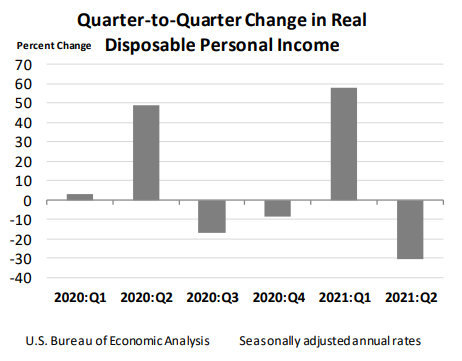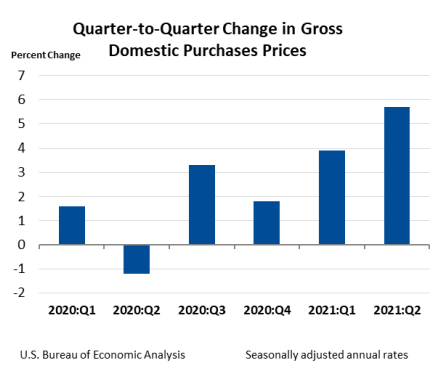Real gross domestic product (GDP) increased at an annual rate of 6.5 percent in the second quarter of 2021, reflecting the continued economic recovery, reopening of establishments, and continued government response related to the COVID-19 pandemic. In the second quarter, government assistance payments in the form of loans to businesses and grants to state and local governments increased, while social benefits to households, such as the direct economic impact payments, declined. In the first quarter of 2021, real GDP increased 6.3 percent (revised). For more details, including source data, see the Technical Note and Federal Recovery Programs and BEA Statistics.
GDP highlights
The second-quarter increase in real GDP reflected increases in consumer spending, business investment, exports, and state and local government spending that were partly offset by decreases in inventory investment, housing investment, and federal government spending. Imports, a subtraction in the calculation of GDP, increased.
- The increase in consumer spending reflected increases in services (led by food services and accommodations) and goods (led by other nondurable goods, notably pharmaceutical products).
- The increase in business investment reflected increases in equipment (led by transportation equipment) and intellectual property products (led by research and development).
- The increase in exports reflected an increase in goods (led by non-automotive capital goods) and services (led by travel).
- The decrease in inventory investment was led by a decrease in retail inventories.
- The decrease in federal government spending primarily reflected a decrease in nondefense spending on intermediate goods and services. In the second quarter, nondefense services decreased as the processing and administration of Paycheck Protection Program (PPP) loan applications by banks on behalf of the federal government declined.
Personal income and saving
Real disposable personal income (DPI)—personal income adjusted for taxes and inflation—decreased 30.6 percent in the second quarter after increasing 57.6 percent (revised) in the first quarter.
The decrease in current-dollar DPI primarily reflected a decrease in government social benefits related to pandemic relief programs, notably direct economic impact payments to households established by the Coronavirus Response and Relief Supplemental Appropriations Act and the American Rescue Plan Act. Personal saving as a percent of DPI was 10.9 percent in the second quarter, compared with 20.8 percent (revised) in the first quarter.
Prices
Prices of goods and services purchased by U.S. residents increased 5.7 percent in the second quarter after increasing 3.9 percent (revised) in the first quarter.
- Energy prices increased 20.6 percent in the second quarter while food prices increased 2.0 percent.
- Excluding food and energy, prices increased 5.5 percent in the second quarter after increasing 3.2 percent in the first quarter.
Annual Update of the National Economic Accounts
Today’s release also reflects the Annual Update of the National Income and Product Accounts; the updated Industry Economic Accounts will be released on September 30, 2021, along with the third estimate of GDP for the second quarter of 2021. For more details, see Information on Updates to the National Economic Accounts.
For more information, read the full report.


